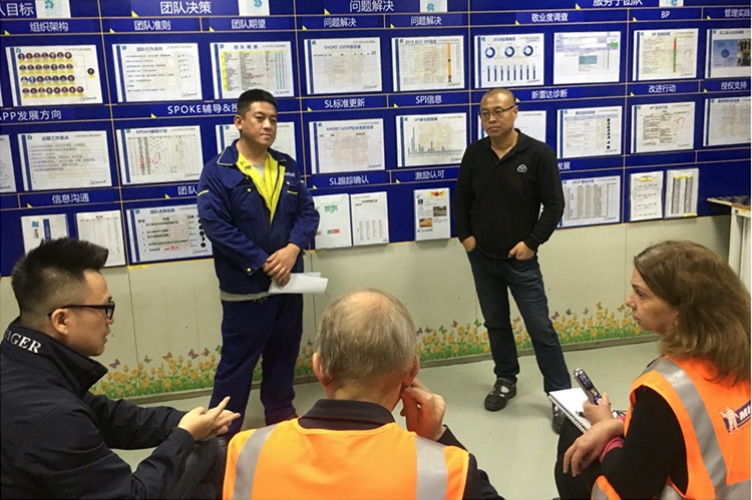Research Highlight Empowering employees in the age of the digital revolution: a practical approach
How can digital transformation be leveraged to renew employee empowerment? And vice versa? A case study of tire giant Michelin's most forward-thinking production plant helps shed light on the symbiotic interactions between the digitalisation of production activities in specific work situations and the empowerment of production teams. The findings open new avenues for human resources within the industry of the future.
While the term ‘ethnographic study’ tends to conjure images of academics in safari suits crouching in the dirt scribbling notes on the ritual body-scarification customs of some tribe in a remote African valley, two researchers recently conducted a (quasi-)ethnographical enquiry of a more modern sort. They immersed themselves in tire giant Michelin's Shenyang 2 factory in North-East China, where 3,000 employees produce tens of millions of tires per year. There, Ann-Charlotte Teglborg from ESCP Business School and Patrick Gilbert from IAE Paris observed processes on the shop floor, analysed internal documents and led individual and group interviews on the topic of digital transformation and employee empowerment, two domains in which Michelin enjoys a strong reputation.
The questions they wished to answer were the following: How do the interactions between digital transformation and empowerment manifest themselves in professional situations? In what ways is empowerment renewed in the context of industrial processes digitalisation? And, last but not least, what are the implications of all this for human resources management?
Very little is known about how digital transformation can foster a renewed approach to empowerment.
Indeed, while the digital transformation has swept through industry as a whole, to the point that it is being trumpeted as a “digital revolution”, with 4.0 factories no longer a thing of the future, “very little is known about how digital transformation can foster a renewed approach to empowerment,” write the two researchers in their case study. After all, empowerment – a concept originally used in the literature on gender and minorities – is at the core of key definitions in management literature. It is broadly defined as “[enabling] individuals or teams to make responsible decisions about the jobs they do; it involves management sharing relevant information about and control over factors that impinge upon effective job performance.”
Not only does empowerment appear as a central condition for managing the complexity of production, but, more recently it has been intimately linked with digital transformation, point out the authors. But how to understand the relationship between technical and social change?
Beyond social and technological determinism: the symbiotic approach
Professors Teglborg and Gilbert chose to break away from the archetypal opposition between technological determinism (which postulates that technology has a determining influence over the social) and social determinism (briefly put, the impact of technology depends entirely on human actions). Instead, they opted for an anthropotechnical approach, which focuses on the interactions between both types of systems.
Digital technology is thus framed as “an organism which exists in a symbiotic relationship with humans (man-computer symbiosis)”. The term symbiosis, borrowed from biology, evokes a very close partnership – not The Matrix, of course, but mutually beneficial actions, for example with humans enjoying higher capacities thanks to digital tools, which in turn are improved by the successive upgrades they receive.
The symbiotic relationship is defined by four main mechanisms:
- Co-extension, whereby humans transfer to their symbionts tasks to which they are suited;
- Co-evolution, whereby humans and technology benefit from continuous adaptation;
- Co-action, whereby humans and technology work together, with constant feedback loops;
- Co-dependency, whereby both parties are mutually dependent.
Customer risk as a determinant of cash-holding choices
Thomas David identified one under-documented source of risk exposure: supplier-customer relationships. Indeed, one of the major determinants of customer quality is the ability of a customer firm to honor its debts on time, if at all. In other terms, if customers fail to settle their bills, supplier firms face a higher operating risk through the potential loss of cash flows, which in turn for them means trouble meeting debt repayment deadlines.
Hence the professor's main hypothesis: Firms facing higher customer risk rely less on lines of credit as a source of liquidity (as opposed to relying on cash). To test it, he built a comprehensive sample of corporate loans for more than 8,000 US industrial firms covering more than a quarter of a century, then created a matched buyer-supplier sample. His results indeed exhibited a negative and significant correlation between customer risk and the relative reliance on credit lines.
Digital dashboards and QR codes to better manage rubber
During their immersion at Michelin's Shenyang 2 plant, the researchers identified seven relevant working situations involving new interactions between employee involvement and the digital solutions developed, thus enriching the conceptual techno-symbiosis framework of HTSRs (human-technology symbiotic relationships). They also related them to the four foundations of Michelin's approach to empowerment: shared objectives, decision-making, problem-solving and serving the team.
For example, an e-kanban (a digital workflow board) was developed for operators to be able to visualise their stock levels of the different tires. Instead of relying on orders from the planning department as was the case in the past, operators at their work stations are now able to decide which production to prioritise based on the information displayed in real time. The new HTSR could be described as a co-extension, but co-dependence is also at play, since decisions are based on the information displayed, while the decisions also impact the figures on display.
[HR and the digital team] act as strategic partners and drivers of change.
Also in the area of decision making, a collective internal recruitment process was set up that can be described as co-action, with human beings and the technology acting together. Vacancies are posted in the form of a QR code on a shared WeChat; the QR code is not only used for applicants to find out details of the position, but also for team members to vote for applicants. Since the project was improved with several iterations of learning, it can also be described as a bottom-up co-evolution project.
Another example of HTSR is a digital solution called an extruder dancer, which monitors the position of the tool measuring the thickness of the layer of rubber on a tire and helps operators identify potential quality issues rapidly. Again, this specific solution (a co-extension) was developed by technicians and digital teams working hand-in-hand.
HR as a co-conductor of symbiotic change
The authors note that at the organizational level, “the digital transformation alongside the development of empowerment took place in a context of strong collaboration between the digital team and the HR team animated by the will of fostering organisational learning.” Their results also show that at the team level, the process “reshuffled the cards of the empowerment of production teams”, and likewise at the individual level.
Another major lesson is thus that the classical HR functions can be renewed, as HR, alongside the digital team, is a co-conductor of symbiotic change. “[HR and the digital team] act as strategic partners and drivers of change, playing complementary roles and expertise in the learning dynamic within the plant as a whole and, at the local level, thanks to tailor-made coaching.”
The authors do warn, however, that digitalisation may clearly renew forms of empowerment, but that it also means managers can more easily control their employees, so particular care should be taken when implementing new solutions.
AUTHORS
 Patrick Gilbert Professor Emeritus of Management and Psychology at IAE Paris
Patrick Gilbert Professor Emeritus of Management and Psychology at IAE Paris Ann-Charlotte Teglborg Associate Professor of Sustainability at ESCP Business School (Paris campus)
Ann-Charlotte Teglborg Associate Professor of Sustainability at ESCP Business School (Paris campus)Campuses
